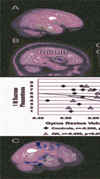Localized brain volume and white matter integrity alterations in adolescent anorexia nervosa
- PMID: 24074473
- PMCID: PMC4082770
- DOI: 10.1016/j.jaac.2013.07.007
Localized brain volume and white matter integrity alterations in adolescent anorexia nervosa
Abstract
Objective: The neurobiological underpinnings of anorexia nervosa (AN) are poorly understood. In this study, we tested whether brain gray matter (GM) and white matter (WM) in adolescents with AN would show alterations comparable to those in adults.
Method: We used magnetic resonance imaging to study GM and WM volume, and diffusion tensor imaging to assess fractional anisotropy for WM integrity in 19 adolescents with AN and 22 controls.
Results: Individuals with AN showed greater left orbitofrontal, right insular, and bilateral temporal cortex GM, as well as temporal lobe WM volumes compared to controls. WM integrity in adolescents with AN was lower (lower fractional anisotropy) in fornix, posterior frontal, and parietal areas, but higher in anterior frontal, orbitofrontal, and temporal lobes. In individuals with AN, orbitofrontal GM volume correlated negatively with sweet taste pleasantness. An additional comparison of this study cohort with adult individuals with AN and healthy controls supported greater orbitofrontal cortex and insula volumes in AN across age groups.
Conclusions: This study indicates larger orbitofrontal and insular GM volumes, as well as lower fornix WM integrity in adolescents with AN, similar to adults. The pattern of larger anteroventral GM and WM volume as well as WM integrity, but lower WM integrity in posterior frontal and parietal regions may indicate that developmental factors such as GM pruning and WM growth could contribute to brain alterations in AN. The negative correlation between taste pleasantness and orbitofrontal cortex volume in individuals with AN could contribute to food avoidance in this disorder.
Keywords: anorexia nervosa; brain; gray matter; white matter.
Copyright © 2013 American Academy of Child and Adolescent Psychiatry. Published by Elsevier Inc. All rights reserved.
Conflict of interest statement
Drs. Hagman and Yang, and Ms. Shott report no biomedical financial interests or potential conflicts of interest.
Figures


References
-
- American Psychiatric Association. Handbook of Psychiatric Measures. 4. Washington DC: American Psychiatric Association; 2000. Diagnostic and Statistical Manual of Mental Disorders - Text Revision (DSM-IVTR)
-
- USDHHS. Eating Disorders Information Sheet. Health. PHSsOiWs. ed2000.
-
- Sullivan PF. Mortality in anorexia nervosa. Am J Psychiatry. 1995;152(7):1073–1074. - PubMed
-
- Kaye WH, Fudge JL, Paulus M. New insights into symptoms and neurocircuit function of anorexia nervosa. Nature Reviews Neuroscience. 2009;10(8):573–584. - PubMed
Publication types
MeSH terms
Grants and funding
LinkOut - more resources
Full Text Sources
Other Literature Sources
Medical
Molecular Biology Databases

